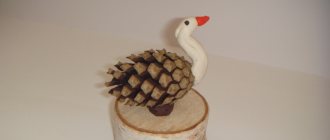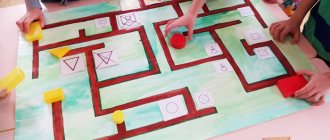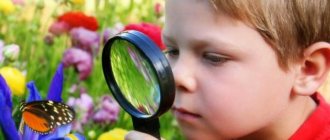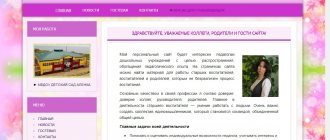Project "Lego construction and robotics" in the preparatory group
Bibliographic description:
Basanets, L. A. Project “Lego construction and robotics” in the preparatory group / L. A. Basanets, Yu. O. Stepanenko. — Text: direct // Questions of preschool pedagogy. — 2021. — No. 6.1 (23.1). — P. 3-5. — URL: https://moluch.ru/th/1/archive/128/4242/ (access date: 12/19/2021).
Project type: educational and gaming
Project duration: long-term (September - May)
Project participants: preparatory group children, teachers, parents.
Relevance of the project
Construction is one of the most popular and common types of development of fine motor skills, as well as speech, thinking, imagination, attention, memory, and intelligence in children. This project is relevant because it opens up the world of technology and design for older preschoolers. In addition, children become familiar with spatial indicators such as symmetry and asymmetry.
A modern child strives to understand the environment; he is interested in everything unknown, the structure of the world, the past and the future. He asks a lot, reasons, expresses his guesses, thinks and offers his own ways to solve existing problem situations. But not every adult knows and realizes that children play in order to learn to master the objects around them, that is, to acquire skills, knowledge and skills. LEGO building, more than other activities, prepares preschoolers for the ability and development of technical skills. The use of LEGO construction sets is an excellent tool for the intellectual development of preschool children, ensuring the integration of various types of activities. The program is integrated in nature and is based on an activity-based approach to learning. Working with LEGO constructors promotes the development of spatial thinking, since three-dimensional design is much more difficult than laying out any models on a plane. At the same time, the child pays attention not only to the general appearance of the future structure, but also to every detail of it.
Formulation of the problem
Nowadays there is an acute problem of organizing work to intensify cognitive interest in technical creativity and the formation of initial technical skills. When solving this problem, teachers are faced with the lack of necessary special conditions in the institution for the development of design and robotics. Therefore, the need to introduce LEGO construction and robotics into the educational process of kindergarten makes it possible to create favorable conditions for introducing preschoolers to scientific and technical creativity through LEGO construction and robotics and the formation of initial technical skills.
The goal of the project: to introduce preschoolers to children's scientific and technical creativity through LEGO construction and robotics.
Project objectives:
– to develop skills and abilities in LEGO construction, to facilitate the acquisition of initial experience in solving design problems;
– promote the development of cognitive interest in LEGO construction and robotics;
– develop visual perception, logical thinking, working memory, fine motor skills, spatial orientation.
Methods and forms of work:
– accessibility and visibility;
– consistency and systematicity of training and education;
– taking into account the age and individual characteristics of children.
When working with families, the following forms of work are used:
– participation of parents in enriching the subject-development environment;
– familiarizing parents with the meaning and possibilities of Lego construction;
– instilling the traditions of Lego construction in family pedagogy.
Expected results:
Children will learn:
– build positive self-esteem and self-confidence through creating a situation of success in the classroom;
– develop logical thinking and creative abilities;
– enrich the lexical vocabulary of preschoolers, including technical vocabulary;
– develop attention and patience, calmly experience failures and be persistent on the path to the goal.
Event schedule:
| date | weeks | Work with children | Working with parents | Improving the subject-development environment |
| September | 1. | D/game “Colorful trailers” D/exercise "Find by touch" | Parent meeting “Introduction to Lego Design” | Making children's robots from Lego constructors |
| 2. | D/exercise "Wonderful bag" D/game “Colored lanterns” | |||
| 3 | D/exercise "What changed?" D/game “Yes-no” | |||
| 4 | D/game “On the contrary” D/exercise “Collecting and counting” | |||
| October | 1 | D/game “Colored rugs” D/exercise "Make a whole from parts" | ||
| 2 | D/exercise "Traffic light" D/game “Name and Build” | |||
| 3 | D/exercise "Lego gifts" D/game “Don’t take the last die” | |||
| 4 | D/game “Merry little engine” D/exercise "Remember the location" | |||
| November | 1 | D/game “Fish, Beast, Bird” D/exercise “Assemble the model from memory” | Consultation “Involving children in children's scientific and technical creativity” | Enriching the subject-development environment with the help of parents. |
| 2 | D/exercise "Post the other half" D/game “Our wonderful plane” | |||
| 3 | D/exercise "Make a pattern" D/game “Let’s build turrets” | |||
| 4 | D/game “Select similar” D/exercise "Tic Tac Toe" | |||
| December | 1 | D/game “Make no mistake Parsley!” D/exercise "Colorful Mugs" | ||
| 2 | D/exercise "Guess it" D/game “Assemble the Christmas tree” | |||
| 3 | D/exercise "Lego - gifts" D/game “Animals in the forest” | |||
| 4 | D/game “What has changed?” D/exercise “Name it and tell it to me” | |||
| January | 2 | D/exercise "On the contrary" D/game “Find out and compare” | Folder for parents “Design and robotics” | |
| 3 | D/exercise "Remember the location" D/game “What’s extra?” | |||
| 4 | D/game “Collect the picture” D/exercise "Make a pattern" | |||
| February | 1 | D/game “Beast, fish, bird” D/exercise "Build a Snowman" | ||
| 2 | D/exercise "Select similar" D/game “Wonderful bag” | |||
| 3 | D/exercise "Lay out your other half" D/game "Houses" | |||
| 4 | D/game “Assemble a car” D/exercise "Lanterns" | |||
| March | 1 | D/game “Remember the location” D/exercise “What color is missing?” | Open lesson for parents “Assemble a pattern” | Preparation of didactic material for open classes |
| 2 | Modeling “Assemble a rug from colored pieces” D/game “Tic Tac Toe” | |||
| 3 | D/exercise "Collect a flower" D/game “Assemble a model from memory” | |||
| 4 | D/game “Labyrinths” D/exercise “Collecting and counting” | |||
| April | 1 | D/game “Don’t take the last die” D/exercise "Multi-colored stream" | ||
| 2 | D/exercise "Spring flowers" D/game “Find the same one” | |||
| 3 | D. control "Sun" D/game “Pick up the rays” | |||
| 4 | D/game “Lay out according to the model” D/exercise "Guess it" | |||
| May | 1 | D/game "Merry caterpillar" D/exercise "Make a pattern" | Creative competition among parents “Make it with your child” (Making an educational game with your own hands) | Designate an area for the material used to develop initial technical skills |
| 2 | D/exercise "Colored rugs" D/game “Big, medium, small” | |||
| 3 | D/exercise "Collect a butterfly" D/game “Fold the Rainbow” | |||
| 4 | D/game “Assemble a house” D/exercise “Lay out the figures from memory” |
Key terms
(automatically generated)
: game, LEGO, logical thinking, fine motor skills, skill, cognitive interest, the last brick, subject-development environment, involvement of preschoolers, work.
CONSTRUCTION PROJECT “We imagine, we create, we design!”
Accessibility and visibility
Integration of developmental training,
Individualization and differentiation of the educational process,
Active development of emotional-aesthetic and moral-evaluative attitude towards reality, nature, psychological comfort and variability.
The principle of phasing, which entails the distribution of activities between all participants in the educational process.
Approaches to project formation:
Personality-oriented:
The pedagogical process has an active and creative nature, which allows, through reliance on systems of interrelated concepts, ideas and methods of action, to ensure and support the processes of self-awareness, self-expression of the child’s personality, and the development of his unique individuality
Individual:
It involves the widespread introduction of new non-traditional forms and methods of education, providing an individual approach to each child, with the aim of developing individuality
Cultural:
Creating conditions for the most complete (taking into account age) acquaintance with the achievements and development of the culture of modern society and the formation of various cognitive interests in folk art and the history of their homeland
Differentiated:
Differentiation in various types and forms is assumed, taking into account individual-typological characteristics of the individual in the form of grouping of students and different construction of the learning process in selected groups.
Activity:
It is based on the concept of “leading activity” existing in psychology. The draft stipulates that the “leading activity” is constructive activity.
Project stages
Preparatory
Questioning parents;
selection, analysis of programs and methodological literature;
selection of materials and equipment for design;
selection of consultations for parents about the importance of design in
development of cognitive and research activities of children;
Basic
Project implementation activities;
GCD, joint activities, observations;
Final
Analysis of project results
Type of construction material:
1. Building material - volumetric (or planar) wood
painted (or unpainted) building parts simple
geometric shape.
2. Paper, sticks.
3. Colored soft and hard volumetric large-sized modules.
4. Different types of constructor.
Project result
The main feature of children's design is the establishment of the spatial arrangement of the elements of an object and its subordination to a certain logic. During the implementation of the project, children name and recognize the details of the LEGO and Baby construction sets, can replace the missing part with a similar one, and are able to create structures from different types of construction sets at their own request; know how to use different means to achieve results (diagrams, models, drawings, samples). The unity of the children's team is observed: the skills of cooperation with a partner have been formed, the pupils are able to solve problems together, distribute roles, explain to each other the importance of this constructive solution, strive to become a participant in a collective role-playing game using crafts from various types of construction sets.
Project in the senior group on light engineering
Slide description: December 1. Winter fun 2. New Year's kaleidoscope 1. Modeling a snowman and building a winter playground 2. Creating a fairy-tale vehicle - teach how to create a plot composition on a board, consolidate skills in building fences and gates, develop children's imagination and creativity. Continue to learn how to compare structural parts by color, shape, size. Encourage the desire for constructive activity, the creation of structures that correspond to the purpose of the intended object. teach planning work using a story about a planned subject, develop imagination and constructive imagination. To develop and support children’s plans in the process of developing constructive activities, and to help in its implementation. To develop the ability to use acquired knowledge in independent buildings. January 1. Furniture 2. Our life - dishes, food 1. Furniture 2. Design by design to develop the ability to identify their functional parts in real objects; learn to analyze a sample. To develop the ability to analyze an object, identify its main parts and details, their components, determine their size, shape, spatial relationships of parts, determine their purpose. Practice selecting parts in accordance with a phased graphical model. teach in advance, think about the content of the future building, give its general description; develop creative initiative and independence. Learn to build in a given sequence, understand its feasibility. Strengthen the ability to select structural parts necessary for construction in accordance with the subject and graphic sample. February 1. Transport 2. Military equipment 1. Train 2. Airplane introduce techniques for connecting bricks with wheels, with each other, with the main parts of the train; develop fantasy and imagination. To develop skills that ensure the identification of characteristics and properties inherent in a sample, and to form, on this basis, generalized ideas about the object being designed. Practice building a familiar design using a graphic model, correlating the elements of the graphic model with parts of the object. talk about the profession of a pilot; teach how to build an airplane, highlighting the functional parts; develop interest and creativity. Teach children to independently find individual ways to solve a given problem related to rebuilding a building in accordance with given conditions. Encourage children to reason out loud when solving a constructive problem, and encourage such manifestations.




